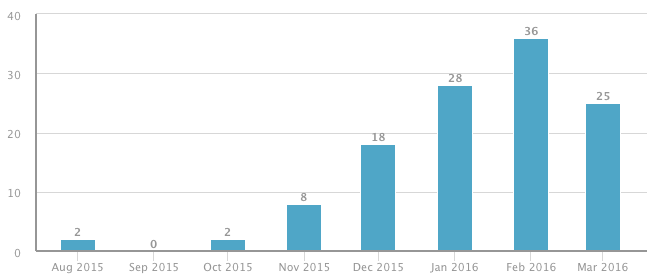College websites are scary. Trying to find the information you’re looking for hidden on the website is even scarier. College sites are complicated webs of information-heavy pages that often lead visitors down a path they didn’t intend to go.
But it doesn’t have to be this way.
More and more website development teams are embracing a growth driven design mentality to launch cleaner websites more quickly and start collecting valuable data for their clients. While website development plans vary greatly depending on the size of the school (and subsequently, the website), we’ve seen the growth driven design mentality yield great results for higher education, which we discuss later in this post.
But first, let’s explore what the growth driven design method entails.
What is Growth Driven Design?
Growth Driven Design (GDD) is a smarter approach to web design that reduces the headaches caused by traditional web design, maximizes results and informs other parts of the business (marketing and sales) on how they can improve and vice versa. With a GDD philosophy, the short-term goal is launching a minimum viable product to start collecting data right away. The long-term goal is continuous improvement backed by user data.
Traditional website design is often driven by highly-involved creative and industry trends and best practices. Unfortunately, these standards don’t always have the best interest of the user in mind. Actions are driven by designers, not the users. For better websites that yield better results, that formula needs to be flipped: users dictate the action based off of behavior and data. With a “user-first” mentality, you create a website that provides the right information in the right format to help your customers overcome challenges and meet their goals.
GDD boils down to two phases: Phase 1 (Foundation) and Phase 2 (Continuous Improvement).
Phase 1: Foundation
The Foundation phase consists of two stages – strategy and the launch pad website. The entire phase can be completed, including the launch of a live website, in less than three months if done correctly. The goal during the strategy stage is to brainstorm a wish list of elements that solve user challenges and drive value.
Remember: With GDD, our primary focus is understanding users and how to best fit the website into their lives.
During the strategy stage, you’ll go over goals, buyer personas, fundamental assumptions and journey mapping to create a master wishlist of items that will drive the direction of your launch pad website. (I’ll go more in-depth on this topic in one of my next posts, stay tuned.)
After creating a solid strategy, we start work on the launch pad website.
Remember: This is a minimum viable product with the goal of launching a site quickly in order to make more informed decisions based on real user data.
It’s tricky balancing speed with quality and client happiness, but it can be done. Using the wishlist from the strategy stage, we filter and prioritize items into “must-haves” and “nice-to-haves” to zone in on the core features of the launch pad website.
Remember: We’re looking to provide only the absolutely essential information in a user-friendly format, so right now, less is more.
This is where GDD benefits higher education the most. Without a doubt, trying to organize and deliver information about four or five different schools with 10 or 20 programs is a daunting task for anyone. But by keeping everyone aligned with the goal of launching quickly while still maintaining high quality, and reminded that you can always add more after going live, a lot of time, energy and headaches can be saved.
The site build process is optimized to ensure we’re working on the most important items at the right times, with the goal of going live at the end of the third month at the very latest. It’s important not to succumb to “analysis paralysis” during this time. It might be nearly impossible to make everyone happy with the finished product, but we can keep everyone on the same page and working toward the goal of collecting valuable data as soon as possible with the promise of continuous growth, improvement and, of course, better results.
Phase 2: Continuous Improvement
Hooray! We’ve got a great new website that’s collecting real user data to help us narrow in on high-impact items. We work through a continuous cycle of analyzing results, brainstorming ideas, running experiments and planning next steps. We start to tackle some of the “nice-to-have” items and add features and tools to the site that we know users would appreciate.
The GDD mindset focuses on the user, enables creativity, gets stuff done and always digs deeper for more learning opportunities.
You might be wondering if this method is a realistic option for higher education. Well, just take a look at the results it yielded for a technical school in NYC in just five months.
How GDD helped one school in NYC increase organic website traffic by 165% and new leads by 215% in five months
A small technical school came to our agency looking to improve the overall design of their website, which hadn’t been refreshed in nearly a decade, and increase student applications. Ultimately, this client fully bought into the inbound marketing methodology and growth driven design strategy to reach this goal.
Now, we didn’t hit our goal of launching the new site within three months – it was four – but we’d still consider this a huge win in the higher education world. (I’ve heard of some college websites taking six months or even more than a year to launch – yikes.)
We did our research. We laid out a solid plan and launched a greatly-improved website that provided the most important information for the users with very few hiccups along the way.
The results speak for themselves. In the first five months post-launch, organic search traffic to the website went from less than 1,000 visits per month to nearly 2,500 visits per month.
That’s a 165% increase.

Great, we’re driving a lot more users to a site we’re confident in. But did this help the client reach their real business goal of increasing student applications? Short answer – yes. New contacts generated by the website went from less than 40 per month to more than 100.
That’s a 215% increase.

So, how do we know these contacts were really qualified leads? Were these the right students the school was looking to attract?
The chart below shows monthly applicants to the school. Now, we know this was a prime time for applicants anyway as the spring semester started in January, however we saw that the total number of applicants continued to trend higher than before, even after the spring application deadline.

And when we compare year over year (January-March 2015 compared to January-March 2016), total applicants went from 31 to 89 in that same three-month period.
That’s a 187% increase.
Like I said, the results speak for themselves.
So how did we use growth driven design to reach this goal? We kept it simple.
We can attribute these results to three factors:
- Fewer pages = More results. Each program the school offered had exactly one website page. Yes, one. Each program page provided an overview of the degree, course requirements and career opportunities.
- Valuable, free premium content. We knew that providing the bare essentials on each program page could leave prospective students with many unanswered questions. So, instead of creating more content that would weave a complicated navigation web, we wrapped all this great information into a free eBook offer that was promoted on the program pages. These landing pages averaged a 40% conversion rate and served as not only a hugely valuable resource for prospective students, but a great sales tool for the admissions team.
- Focused call-to-action. And it wasn’t “Apply now!” Why? Because the large majority of website visitors are nowhere near ready to apply. This is the mistake that so many colleges make with their website. Instead, we heavily promoted the Open House, which conveniently the school held multiple times per month. This landing page averaged a 15-20% conversion rate, growing from roughly 10 registrants per month to more than 30 registrants per month. Many Open House attendees ultimately applied in-person at the school, helping our client reach that same goal of increased applicants.
Does GDD work for any college and/or university?
As you’d expect, the larger the college, the more involved a website build is, no matter how simple you try to make it. Whether your college website is 20 pages or 2,000 pages, the basic mentality and principles of growth driven design can still apply. Start with the student in mind, prioritize user experience and simplicity and always keep everyone on the team aligned with the main goal of making user-dictated decisions.


